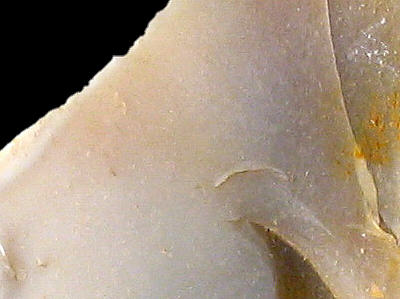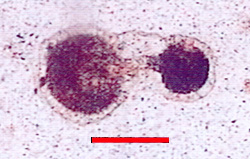
Foto: Jehanne Féblot-Augustins, 2005.
- Les Brovières 4
Sampled sites:
| Material name: | CN7 |
| Synonyms: | Silex Crétacé supérieur Nord - Sénonien (Campanien) |
| Material (geologic): | Late Cretaceous (Senonian, Campanian) flint |

Foto: Jehanne Féblot-Augustins, 2005. |
Sampled sites:
|
| Mode of occurrence: | A single large and relatively regular nodule. |
| Cortex: | Thin (<1 cm), smooth and worn, highlighted by a thin white line forming a sharp transition with the flint. |
| Colour: | Originally light grey (2.5Y N6.5/), but mostly stained a light brownish grey (2.5Y 6/2) by the enclosing clay. |
| Pattern: | Featureless within the grey and brown areas. |
| Appearance: | The nodule itself lacks homogeneity (micro-vugs and pores, patches of unreplaced matrix), but the flakes detached are reasonably homogeneous; material with a medium lustre (in the grey areas), opaque, smooth, fine-grained. |
| Structure: | Displaying locally a fluidal arrangement of rains. |
| Texture: | Mudstone to wackestone depending on the areas. |
| Matrix: | Semi-opaque. |
| Grains: | 7.5 to 20 %, white to milky, rounded with high to low sphericity, contained between 100 and 200 µ). |
| Grain composition: | Numerous elongated and fuzzy elements (bryozoan fragments?), planktonic echinoderms, some thin-walled monaxon sponge spicules, globose planktonic foraminifera (e.g. Archaeoglobigerina blowi). |
 Globotruncanidae (Archaeoglobigerina blowi) in a CN7 flint type. |
||
|
Photo: A. Arnaud Vanneau, (Laboratoire de Géodynamique des Chaînes Alpines, Grenoble) Determination: M. Caron, Université de Fribourg. |
| Further information: | Click here for the original French description (opens in a new window), or here for more information on the attributes used in the description (use your browser's "BACK"-button to return here). |
| Citing: | Information on citing this page can be found here. |
| Locality: | Jujurieux / Chenavel - Les Brovières 4, France, Ain department |
| Synonyms: | Sampling site Bugey 69 after Féblot-Augustins |
| Geographical description: | The sampling site is one of a small cluster, together with Les Brovières 2 & 3, which lies approx. 150 metres above the bottom of the valley in a bend of the river Ain, about a kilometre and a half southwest of Poncin, and a kilometre to the north of Chenavel. |
| Geographical co-ordinates: |
east/x 836.4 north/y 2124.1 (Lambert zone II, NTF)
This corresponds with |
| Co-ordinate precision: |
The coordinates given were taken from a large-scale map, and are within approx. 50 metres of the actual spot. The latitude/longitude coordinates are a direct transformation of these data on WGS84 and are accurate to the same level, the apparently high precision to the second is given to prevent the introduction of a rounding-error The location can be found on the 1:25 000 topographical map sheet 3130 E of the French Institut Géographique National. |
| Geology: |
The sample consists of surface collected flint from an patch of clays-with-flints, which represent the residue of weathered material of various geological origins (Early and late Cretaceous). Map of all sampled localities of Late Cretaceous flint in the Bugey (PDF, 54 KB, opens in new window). |
| Type of source: | Secondary. |
| Other types of flint: | Apart from the singular material CN7, the more common CN4a flint can be found here too. |
thumb.jpg) Foto: Jehanne Féblot-Augustins, 2005 |
thumb.jpg) Foto: Jehanne Féblot-Augustins, 2005 |
| Last modified on: November 15, 2005 |
Contents primarily by: Jehanne Féblot-Augustins |
Comments to: |